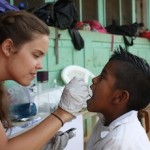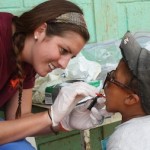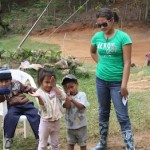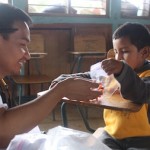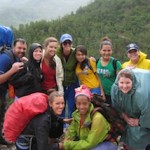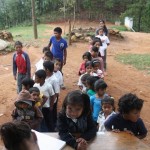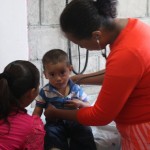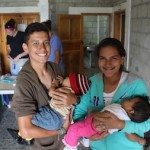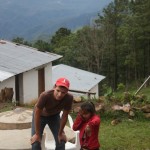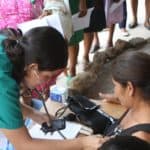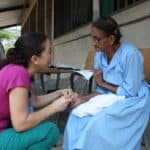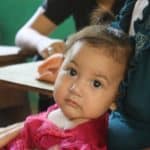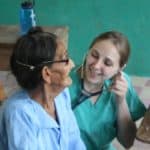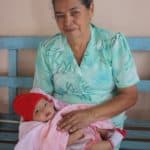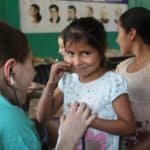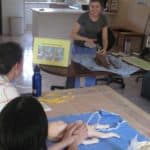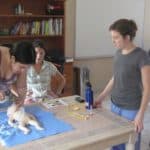Between June 11 and 22, a medical brigade from Virginia Commonwealth University joined Shoulder to Shoulder in the Pinares area of San Marcos de la Sierra. Since 2006, VCU has regularly visited this area. They visit three times annually, and generally include medical students, family medicine residents, and family medicine faculty. Over the years, they have brought dentists, sociologists, pharmacists, nurses, public health workers, and interpreters with them.
For two weeks, this group of physicians, medical students, pharmacists and PharmD candidates, MPH candidates, nurses, a paramedic, and student-translators from the bilingual school in La Ceiba engaged the community in the established Children’s Health Initiative (CHI) at local schools and treated patients at the Pinares clinic. The brigade also took in the U.S.A.-Honduras World Cup qualifer event, crowding into a small pulperia with most of the local community to watch the game. Aside from a few bruised egos, the American win did not cause any international incidents.
Every day, the brigade split into two teams. One group treated patients at the Pinares clinic, treating farming injuries, providing prenatal check-ups, pregnancy exams, and more. The CHI group hiked to a different school each day and set up health stations to address all areas of the children’s health. These included measuring height and weight, taking their hemoglobin, eye exams, fluoride rinses, and visits with physicians.
During one home visit, the brigade examined a 31-year-old patient who had been experiencing abdominal pain. The man had not eaten or drank anything for over a day, and hadn’t moved in two days. Entering the darkened home, the brigade was greeted by a prayer group who had been standing vigil over the sick man all day. The brigade members evaluated the man and determined he needed hospital treatment. As a team, the brigade carried the patient up the steep slopes to the road and drove him to the hospital.
The Pinares and outer communities in San Marcos de la Sierra are very remote and mountainous. Away from the main road to La Esperanza, many locals must walk for hours to receive medical attention. VCU’s CHI group enabled them to evaluate and treat a large volume of geographically diverse group of needy children in the schools. Throughout the year, Shoulder to Shoulder’s health promoters and home health medical teams visit these remote communities and homes to ensure that children, elderly, pregnant, and high-risk patients are receiving the attention they deserve.
Thank you to VCU for your tremendous team effort and support of the Pinares and San Marcos de la Sierra communities!
Brigade Update: Johns Hopkins
Led by Dr. Ed Zuroweste, Drs. Laurel Pellegrino, Lila Worden, Brett Wanamaker, three Johns Hopkins fourth-year residents, Dr. Mish Mizrahi, a family practice attending physician from UCLA, and Mike Piorunski, an Environmental and Occupational Health Program Associate with the Migrant Clinicians Network, the Johns Hopkins brigade spent two weeks immersed in the daily healthcare needs of the Santa Lucia area.
Accompanied by our nurses and Social Service doctors, they visited some of our most remote clinics and communities. While some students attended patients in our traditional field clinics, others assisted with the vaccinations. Dr. Pellegrino, who will begin her Psychiatry residency in July, had the opportunity to see patients in her field at the Santa Lucia clinic. Brigade members conducted home visits and gave charlas, or health education talks, to hypertensive, diabetic, and pregnant patients. Both the students’ and the audience’s favorite tool, by far, was a sugar-filled zip-lock bag demonstrating the actual amount of sugar in one bottle of Coke.
In their off-time, the brigade forded the Rio Torola, toured the La Esperanza hospital, and played a lot of Catchphrase. This group was open to experiencing everything from grunt work to taking night call and really went above and beyond in filling out our government paperwork. Thank you to Johns Hopkins and Dr. Zuroweste for your continued support, and for the brigade members’ tireless efforts on the ground in Intibucá.
For more photos from the brigade, check our Facebook page.
Research Project Provides Essential Neonatal Resuscitation Education for Resource-Limited Environments
For the last year, Kathryn Taylor (Ohio State B.S. ’12; Harvard M.D. ’17) has been training Shoulder to Shoulder’s physicians, nurses, and local midwives how to save babies’ lives. Based at our Santa Lucia clinic, Kathryn has trained and evaluated our staff for basic neonatal resuscitation techniques as part of a study of Helping Babies Breathe, a joint program of the WHO, Save the Children, and the American Academy of Pediatrics. She teaches a curriculum designed for developing countries in limited resource environments.
Approximately 23% of neonatal deaths worldwide are due to asphyxiation. Helping Babies Breathe was developed on the premise that all babies deserve simple neonatal care, regardless of resources. It focuses on improving outcomes in the neonatal period and reducing birth asphyxia. Each year, an estimated 10 million babies require breathing assistance. However, only one to two percent of babies require advanced care. In hospital-based settings in the rural departments of Honduras, including Intibucá, the neonatal death rate is 46.9 deaths per 1000 live births. In the United States, there are four deaths per 1000 live births.
The course is taught at a fifth grade reading level, and focuses more on facilitation than traditional education – utilizing interaction and practice in pairs. Training partners learn to have a plan and materials in place at the time of delivery, to recognize whether a baby is breathing, and operating under time and pressure constraints in order to have a baby breathing in under a minute.
Kathryn has attended and filmed 78 births at the Santa Lucia clinic. She meets with the labor and delivery team following each birth and leads a debriefing. They review the video and find ways to improve. Kathryn will be spending her final month implementing the program at the main regional hospital in La Esperanza prior to beginning medical school in the fall. Srirama Josyula (Ohio State B.S. ’13; Ohio State M.D. ’18) will continue with the program in Santa Lucia and La Esperanza.


